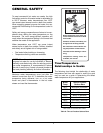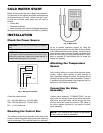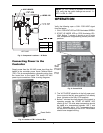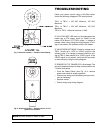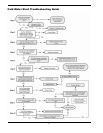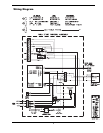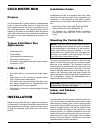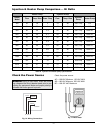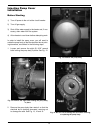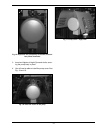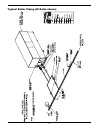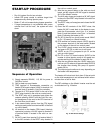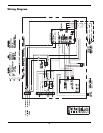
6
Cold Start Sequence of
Operation
1) 120VAC to heater sends 120VAC to Cold Start
control on terminal block 1.
2) 120/24VAC transformer and 120VAC-12VDC con-
verter are powered.
3) 120/24VAC transformer outputs 24VAC to pin 2 of
terminal block 2
4) 24VAC leaves pin 2 of terminal block 2 and goes
to the modulating three way valve on the 20-
30VAC lead, and to the NO contacts of the SPST
relay located in the cold start control panel.
5) 120VAC-12VDC converter outputs 12VDC to pin 3
of terminal block 2.
6) The 12VDC signal leaves pin 2 of terminal block 2
and goes to the common terminal of the reset
switch, located on the bottom of the cold start con-
trol panel.
7) The 12VDC signal crosses over the reset switch
and goes to Pin FS on cold start circuit board.
8) Cold start control remains on standby until a Call
for heat occurs at heater.
9) TRIG terminal of Economaster connection on
heater CPW board outputs 24VAC to terminal 4 of
terminal block 3 located in Cold Start controller.
10) Terminal 4 of TB 3 sends 24VAC to the coil of the
SPST relay located in the cold start control panel.
11) The SPST relay coil is energized and closes the
contacts allowing 24VAC to energize the CFH pin
on the cold start circuit board.
a) A two second delay occurs from the CFH signal
waiting to send power from terminal MC of the cold
start circuit board.
12) J9 terminal on the heater CPW board (interlock
connection) outputs a 24 VAC signal to terminal 2
of terminal block 3 located in the cold start con-
troller.
13) 24 VAC is sent from terminal 2 of terminal block 3
to the NO contacts of the DPST relay located in
the cold start control panel.
14) After the two second delay on the cold start circuit
board, pin MC outputs a 24 VAC signal to the coil
of the DPST relay located in the cold start control
panel.
15) The DPST relay coil energizes and closes the NO
contacts.
16) Once the NO contacts of the DPST close, the
heater 24 VAC is sent back to the heater to com-
plete the Economaster circuit (pin 3 of terminal
block 3) and the interlock circuit (pin 1 of terminal
block 3) allowing the heater to fire.
17) Pin FR on the TVC board outputs 10VDC to the
modulating three way valve actuator to drive it fully
open for two-minutes waiting for the heater to
reach full fire.
18) After the two-minute delay the 10VDC output sig-
nal from pin FR reduces to approximately 8VDC at
the inverter thus slowing the pump to approxi-
mately 50 Hz.
19) The output signal continues to vary depending on
the heater inlet temperature.
The heater will lockout and shut down if the set point
on the inlet temperature is not achieved within seven-
minutes from a call for heat.
The DIP switches on the 3-way valve actuator must be
set as indicated in the Fig. 6.
DIP SWITCH SETTINGS
FOR 3-WAY ACTUATOR
VDC
0-10
DA
FIXED
~
mA
2-10
RA
AUTO
6-9
SWITCH MUST BE IN THIS POSITION
TURN CLOCKWISE TO FURTHEST STOP
MODE SELECTION SWITCH
DIRECT ACTING, ON INCREASING SIGNAL
Fig. 6: Set Dip Switch Settings — Delta Actuator
NOTE: The minimum return water temperature to
the heater to prevent condensate is 105°F on stan-
dard heaters and 120°F on 87% Efficiency heaters.
Ensure that during operation the Set Point Pot is
adjusted properly.
Fig. 7: Delta Actuator — Actuator Shown in Full System
Flow Position





